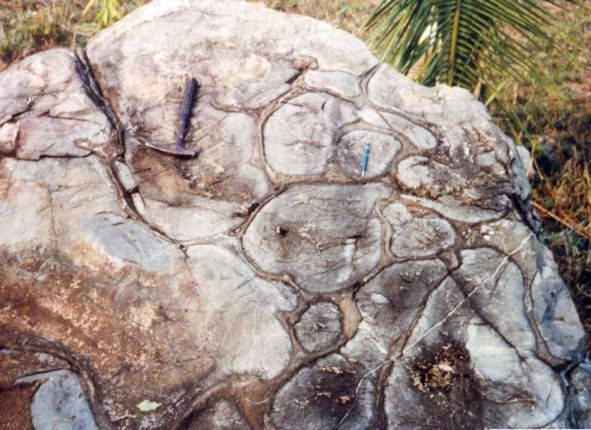

Pillows basálticas do greenstone belt Identidade, sul do Para
Estas pillows ocorrem na seqüência do greenstone belt Identidade, sul do Para, região de Rio Maria - Xinguara (07°12'S x 49°26'W), de idade em torno de 3.1 Ga (ver referencia e abstract abaixo). Os basaltos são toleitos de baixo potassio, fracamente metamorfisados (facies xisto verde), com preservação de texturas intersertal e amigdaloidal, e são considerados como originados da fusão parcial do manto empobrecido.
© Foto e legenda de Zorano Sérgio de Souza (reprodução autorizada citando-se a fonte e créditos)
Souza,Z.; Potrel,A.; Lafon,J.M.; Althoff,F.;
Pimentel,M.M.; D'Allagnol,R.; Oliveira,C.G. 2001. Nd, Pb and Sr of the Identidade
Belt, an Archaean greenstone belt of the Rio Maria region (Carajás Province):
implications for the Archaean geodynamic evolution of the Amazon. Precambrian
Research(2001),109(3-4):293-315.
ABSTRACT: The Rio Maria granite-greenstone terrain
(RMGGT), located in the
Amazonian craton at about 250 km south of the Carajás Ridge, is a well
preserved Mesoarchaean domain composed of metavolcanic rocks and several suites
of granitoids ranging in age from ca. 2.96 to 2.87 Ga. The metavolcanics
comprise a basal unit of komatiites and low-K tholeiites overlain by sodic
metadacites. A Sm-Nd whole-rock reference isochron for the metabasalts,
metagabbros (tholeiites) and metadacites gives an age of 3046±32 Ma (MSWD of
1.6, 1S).
Nd model ages (TDM) of the metadacites range between 3.04 and
3.11 Ga. The ENd
calculated at 3.0 Ga varies from +1.70 to +2.60 for the tholeiites and +0.30 to
+3.22 for the metadacites. A Pb-Pb whole-rock linear array for the metabasalts
yielded an anomalous older age of 3.41 Ga. The Sm-Nd age is coincident, within
analytical error, with a Pb-Pb whole-rock errorchron age of 2944±88 Ma (1S)
obtained for the metadacites. Rb-Sr systematic for the metadacites yielded an
isochron age that is ca. 400 Ma youngest. The isotopic, geochemical and
geological data suggest that oceanic lithosphere was the probable source of the
ultramafic and mafic rocks in such a way that partial melting of the depleted
mantle generated komatiites and low-K tholeiites. Partial melting of oceanic
crust transformed into garnet amphibolite or eclogite generated the parental
magmas of the metadacites. Isotopic and trace element characteristics of both
metavolcanic rocks and associated plutonics suggest intra-oceanic island arcs as
the most probable tectonic setting of the RMGGT. Two main events of crustal
accretion are recognised at about 3.04-2.96 Ga and 2.87 Ga. Geological
correlation indicates that the oceanic island arcs were completely amalgamated
at around 2.76 Ga and acted as sources for the overlying sediments of the Rio
Fresco Group.